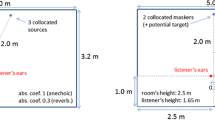Abstract
This study tested the hypothesis that energetic masking limits the benefits obtained from spatial separation in multiple-talker listening situations, particularly for listeners with sensorineural hearing loss. A speech target was presented simultaneously with two or four speech maskers. The target was always presented diotically, and the maskers were either presented diotically or dichotically. In dichotic configurations, the maskers were symmetrically placed by introducing interaural time differences (ITDs) or infinitely large interaural level differences (ILDs; monaural presentation). Target-to-masker ratios for 50 % correct were estimated. Thresholds in all separated conditions were poorer in listeners with hearing loss than listeners with normal hearing. Moreover, for a given listener, thresholds were similar for conditions with the same number of talkers per ear (e.g., ILD with four talkers equivalent to ITD with two talkers) and hence the same energetic masking. The results are consistent with the idea that increased energetic masking, rather than a specific spatial deficit, may limit performance for hearing-impaired listeners in spatialized speech mixtures.






Similar content being viewed by others
References
Agus TR, Akeroyd MA, Gatehouse S, Warden D (2009) Informational masking in young and elderly listeners for speech masked by simultaneous speech and noise. J Acoust Soc Am 126:1926–1940
Best V, Thompson ER, Mason CR, Kidd G Jr. (2013) Spatial release from masking as a function of the spectral overlap of competing talkers. J Acoust Soc Am (in press)
Best V, Marrone N, Mason CR, Kidd G Jr (2012) The influence of non-spatial factors on measures of spatial release from masking. J Acoust Soc Am 13:3103–3110
Bolia RS, Nelson WT, Ericson MA, Simpson BD (2000) A speech corpus for multitalker communications research. J Acoust Soc Am 107:1065–1066
Brungart DS (2001) Informational and energetic masking effects in the perception of two simultaneous talkers. J Acoust Soc Am 109:1101–1109
Brungart DS, Simpson BD, Ericson MA, Scott KR (2001) Informational and energetic masking effects in the perception of multiple simultaneous talkers. J Acoust Soc Am 110:2527–2538
Brungart DS, Chang PS, Simpson BD, Wang DL (2006) Isolating the energetic component of speech-on-speech masking with ideal time-frequency segregation. J Acoust Soc Am 120:4007–4018
Brungart DS, Chang PS, Simpson BD, Wang DL (2009) Multitalker speech perception with ideal time-frequency segregation: effects of voice characteristics and number of talkers. J Acoust Soc Am 125:4006–4022
Byrne DJ, Parkinson A, Newall P (1990) Hearing aid gain and frequency response requirements for the severely-profoundly hearing impaired. Ear and Hearing 11:40–49
Culling JF, Hawley ML, Litovsky RY (2004) the role of head-induced interaural time and level differences in the speech reception threshold for multiple interfering sound sources. J Acoust Soc Am 116:1057–1065
Dillon H (2012) Hearing aids, 2nd edn. Boomerang Press, Turramurra
Dubno JR, Ahlstrom JB, Horwitz AR (2008) Binaural advantage for younger and older adults with normal hearing. J Speech Lang Hear Res 51:539–556
Festen JM, Plomp R (1990) Effects of fluctuating noise and interfering speech on the speech-reception threshold for impaired and normal hearing. J Acoust Soc Am 88:1725–1736
Freyman RL, Helfer KS, Balakrishnan U (2007) Variability and uncertainty in masking by competing speech. J Acoust Soc Am 12:1040–1046
George ELJ, Festen JM, Houtgast T (2006) Factors affecting masking release for speech in modulated noise for normal-hearing and hearing-impaired listeners. J Acoust Soc Am 120:2295–2311
Glyde H, Hickson L, Cameron S, Dillon H (2011) Problems hearing in noise in older adults: a review of spatial processing disorder. Trends Amplif 15:116–126
Glyde H, Cameron S, Dillon H, Hickson L, Seeto M (2013) The effects of hearing impairment and aging on spatial processing. Ear and Hearing 34:15–28
Hall JW, Buss E, Grose JH, Roush PA (2012) Effects of age and hearing impairment on the ability to benefit from temporal and spectral modulation. Ear and Hearing 33:340–348
Helfer KS, Freyman RL (2008) Aging and speech-on-speech masking. Ear and Hearing 29:87–98
Kidd G Jr, Mason CR, Richards VM, Gallun FJ, Durlach NI (2008) Informational masking. In: Yost WA, Popper AN, Fay RR (eds) Auditory perception of sound sources. Springer Handbook of Auditory Research, New York, pp 143–190
Levitt H, Rabiner LR (1967) Predicting binaural gain in intelligibility and release from masking in speech. J Acoust Soc Am 42:820–829
Licklider JCR (1948) The influence of interaural phase relations upon the masking of speech by white noise. J Acoust Soc Am 20:150–159
Marrone N, Mason CR, Kidd G Jr (2008) The effects of hearing loss and age on the benefit of spatial separation between multiple talkers in reverberant rooms. J Acoust Soc Am 124:3064–3075
Moore BCJ (2007) Cochlear hearing loss: physiological, psychological, and technical issues, 2nd edn. Wiley, Chichester
Noble W, Byrne D, Ter-Host K (1997) Auditory localization, detection of spatial separateness, and speech hearing in noise by hearing impaired listeners. J Acoust Soc Am 102:2343–2352
Pollack I, Pickett JM (1958) Stereophonic listening and speech intelligibility against voice babble. J Acoust Soc Am 30:131–133
Spencer NJ, Durlach NI, Colburn HS (2012) Relating performance in speech intelligibility tasks with spatially separated maskers to performance in basic binaural tasks. In: Proc. Assoc. Res. Otolaryng. San Diego
Acknowledgments
This work was supported by grants from NIH/NIDCD and AFOSR.
Author information
Authors and Affiliations
Corresponding author
Additional information
Portions of this work were presented at the Association for Research in Otolaryngology MidWinter Meeting, San Diego, February 2012.
Rights and permissions
About this article
Cite this article
Best, V., Thompson, E.R., Mason, C.R. et al. An Energetic Limit on Spatial Release from Masking. JARO 14, 603–610 (2013). https://doi.org/10.1007/s10162-013-0392-1
Received:
Accepted:
Published:
Issue Date:
DOI: https://doi.org/10.1007/s10162-013-0392-1




